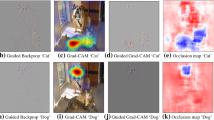Abstract
Increased dependency on artificial intelligence (AI) methods for decision-making has emerged in the recent times. The attention lies in the convolutional networks for efficient feature extractions and the generation of valuable insights with high accuracy. Understanding the internal workings of such complex models to ensure trust in the generated systems is challenging for both the developers and the end-users. A growing study on explainability methods with visualizations focuses on model interpretations. Class Activation Mapping (CAM) in the context is used for visualizing the discriminating regions of the images used by the CNNs for classification. Existing gradient-based CAMs like Grad-CAM, Grad-CAM++, XGrad-CAM have certain disadvantages like saturation and false confidence. Hence, we perform a comparative analysis with some of the recently developed non-gradient CAM approaches like Eigen-CAM, Score-CAM, and Ablation-CAM. The efficiency of these methods has been analyzed using the evaluating metrics of remove and debias on the benchmark datasets.
Access this chapter
Tax calculation will be finalised at checkout
Purchases are for personal use only
Similar content being viewed by others
References
Bach, S., Binder, A., Montavon, G., Klauschen, F., Müller, K.R., Samek, W.: On pixel-wise explanations for non-linear classifier decisions by layer-wise relevance propagation. PloS One 10(7), e0130140 (2015)
Chattopadhay, A., Sarkar, A., Howlader, P., Balasubramanian, V.N.: Grad-cam++: Generalized gradient-based visual explanations for deep convolutional networks. In: 2018 IEEE Winter Conference on Applications of Computer Vision (WACV). pp. 839–847. IEEE (2018)
Mopuri, K.R., Garg, U., Babu, R.V.: Cnn fixations: an unraveling approach to visualize the discriminative image regions. IEEE Trans. Image Process. 28(5), 2116–2125 (2018)
Morcos, A.S., Barrett, D.G., Rabinowitz, N.C., Botvinick, M.: On the importance of single directions for generalization. arXiv preprint arXiv:1803.06959 (2018)
Muhammad, M.B., Yeasin, M.: Eigen-cam: class activation map using principal components. In: 2020 International Joint Conference on Neural Networks (IJCNN). pp. 1–7. IEEE (2020)
Ramaswamy, H.G., et al.: Ablation-cam: Visual explanations for deep convolutional network via gradient-free localization. In: Proceedings of the IEEE/CVF Winter Conference on Applications of Computer Vision. pp. 983–991 (2020)
Rong, Y., Leemann, T., Borisov, V., Kasneci, G., Kasneci, E.: A consistent and efficient evaluation strategy for attribution methods. In: International Conference on Machine Learning. pp. 18770–18795. PMLR (2022)
Russakovsky, O., Deng, J., Su, H., Krause, J., Satheesh, S., Ma, S., Huang, Z., Karpathy, A., Khosla, A., Bernstein, M., et al.: Imagenet large scale visual recognition challenge. Int. J. Comput. Vis. 115(3), 211–252 (2015)
Selvaraju, R.R., Cogswell, M., Das, A., Vedantam, R., Parikh, D., Batra, D.: Grad-cam: visual explanations from deep networks via gradient-based localization. In: Proceedings of the IEEE International Conference on Computer Vision. pp. 618–626 (2017)
Shrikumar, A., Greenside, P., Kundaje, A.: Learning important features through propagating activation differences. In: International Conference on Machine Learning. pp. 3145–3153. PMLR (2017)
Szegedy, C., Liu, W., Jia, Y., Sermanet, P., Reed, S., Anguelov, D., Erhan, D., Vanhoucke, V., Rabinovich, A.: Going deeper with convolutions. In: Proceedings of the IEEE Conference on Computer Vision and Pattern Recognition. pp. 1–9 (2015)
Wang, H., Wang, Z., Du, M., Yang, F., Zhang, Z., Ding, S., Mardziel, P., Hu, X.: Score-cam: score-weighted visual explanations for convolutional neural networks. In: Proceedings of the IEEE/CVF Conference on Computer Vision and Pattern Recognition Workshops, pp. 24–25 (2020)
Zhou, B., Khosla, A., Lapedriza, A., Oliva, A., Torralba, A.: Learning deep features for discriminative localization. In: Proceedings of the IEEE Conference on Computer Vision and Pattern Recognition. pp. 2921–2929 (2016)
Zhou, B., Sun, Y., Bau, D., Torralba, A.: Revisiting the importance of individual units in cnns via ablation. arXiv preprint arXiv:1806.02891 (2018)
Author information
Authors and Affiliations
Corresponding author
Editor information
Editors and Affiliations
Rights and permissions
Copyright information
© 2023 The Author(s), under exclusive license to Springer Nature Singapore Pte Ltd.
About this paper
Cite this paper
Chakraborty, M., Sardar, S., Maulik, U. (2023). A Comparative Analysis of Non-gradient Methods of Class Activation Mapping. In: Bhattacharyya, S., Das, G., De, S., Mrsic, L. (eds) Recent Trends in Intelligence Enabled Research. DoSIER 2022. Advances in Intelligent Systems and Computing, vol 1446. Springer, Singapore. https://doi.org/10.1007/978-981-99-1472-2_16
Download citation
DOI: https://doi.org/10.1007/978-981-99-1472-2_16
Published:
Publisher Name: Springer, Singapore
Print ISBN: 978-981-99-1471-5
Online ISBN: 978-981-99-1472-2
eBook Packages: Intelligent Technologies and RoboticsIntelligent Technologies and Robotics (R0)




